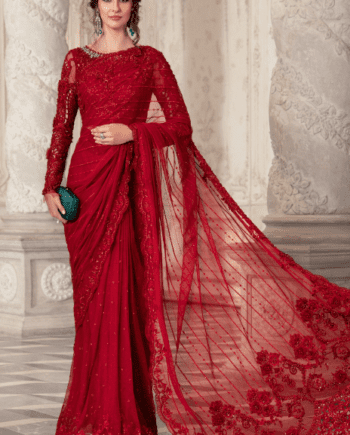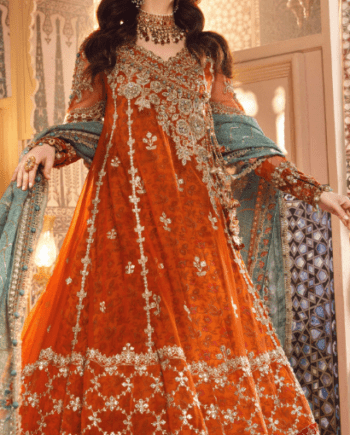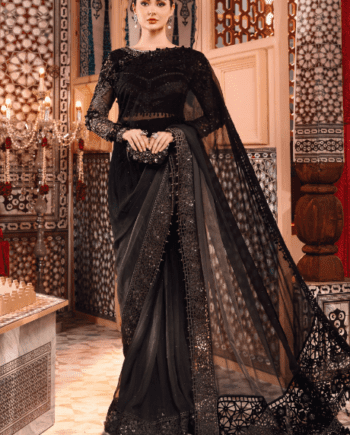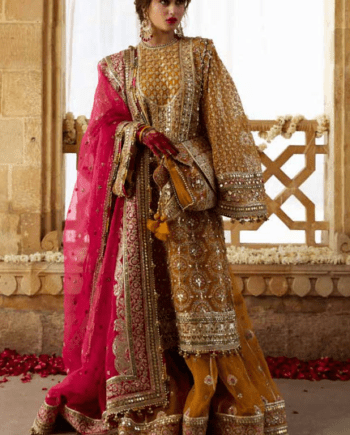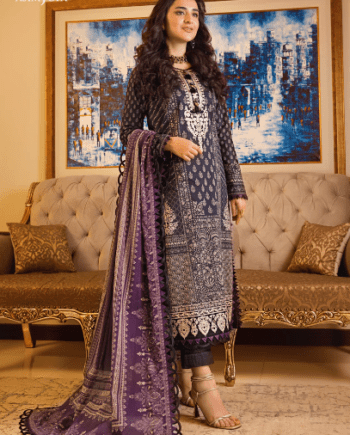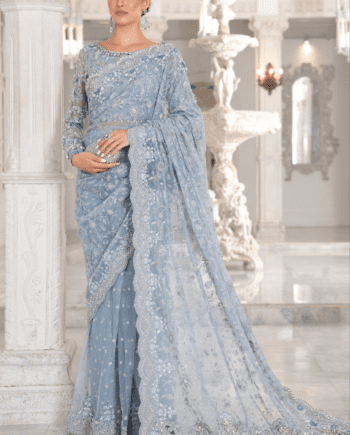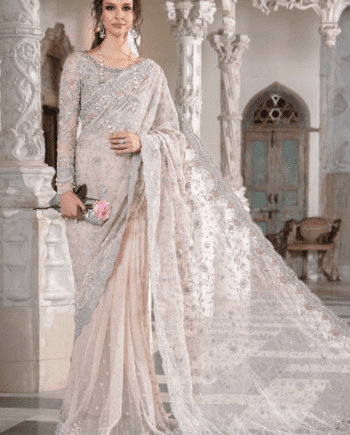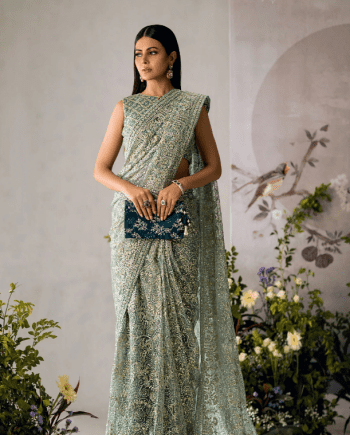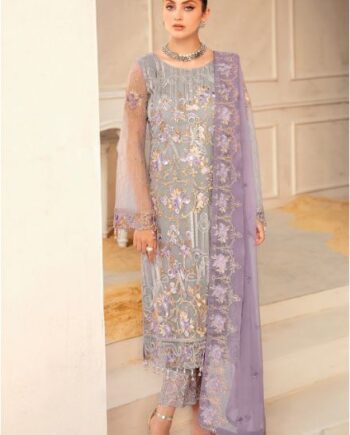Sharara vs. Gharara
In South Asian fashion, the difference between sharara and gharara lies in the distinct charm and cultural richness each brings to traditional attire. Both sharara and gharara outfits have held a special place in bridal wardrobes and festive occasions, cherished for their elegance and the intricate craftsmanship they embody.
These garments aren’t just outfits; they’re pieces of cultural heritage, celebrated across generations for their beauty and historical significance. But what sets them apart, and how do you know which one best suits your style?
For those selecting traditional wear for weddings, festivals, or other significant gatherings, understanding the difference between sharara and gharara can help in making the perfect choice. Let’s delve into the origins, key features, and styling tips for each of these stunning ensembles.
Origins and History of Sharara and Gharara
Sharara and gharara outfits are deeply rooted in South Asian culture, particularly within the Mughal era, which influenced much of the traditional wear seen today. Both styles became prominent among Mughal royalty, reflecting the opulence and luxurious tastes of that period.
- Sharara: Originally popularized in the Awadh region (modern-day Uttar Pradesh, India), the sharara is a flowing pant-style outfit often paired with an embellished long kurta and a dupatta. The sharara’s wide-leg silhouette adds a royal touch, making it a timeless choice for festive gatherings.
- Gharara: The gharara also has origins in Mughal society, with a distinct flair that sets it apart. Known for its knee-length seam that divides the outfit into fitted upper legs and flared lower sections, the gharara has remained a symbol of elegance, often worn by brides and at special celebrations.
Today, these garments continue to captivate fashion lovers, with designers like Asim Jofa New Collection frequently incorporating these timeless styles into their collections.
Key Differences Between Sharara and Gharara
While both sharara and gharara outfits share a similar ethnic appeal, they have specific design elements that differentiate them. Here are the main distinctions:
Sharara
- Pant Style: Sharara pants are known for their wide-leg silhouette, similar to palazzos. They feature a continuous flow from waist to hem, without any seam at the knee.
- Flowy Appearance: The absence of a seam creates a more flowing, unbroken look, adding to the elegance.
- Fabrics and Embellishments: Shararas are often crafted from materials like chiffon, silk, and georgette, adorned with heavy embroidery, zardozi, and mirror work, making them a popular choice for formal occasions.
Gharara
- Divided Pant Style: Ghararas, in contrast, are distinguished by a seam at the knee. This seam is what gives the gharara its unique structure, as the fabric below the knee flares out dramatically, creating a bell-bottom effect.
- Structured Look: The seam at the knee and additional pleating create a structured, voluminous look, giving it a regal flair.
- Fabrics and Embellishments: Ghararas are often crafted from luxurious fabrics such as brocade, silk, and velvet, and are typically paired with rich embroidery and sometimes Maria B Stitched Suits Online in matching colors and designs.
Both sharara and gharara ensembles can be complemented with traditional dupattas and elaborate embellishments, which enhance their beauty and cultural significance.
Styling Tips for Sharara and Gharara Outfits
When it comes to styling, both sharara and gharara outfits offer endless possibilities. Here are some tips to bring out the best in each look:
- Sharara Styling: Pair a sharara with a fitted kurta or a short choli for a balanced silhouette. For a modern touch, consider accessorizing with statement jewelry like jhumkas, bangles, and a maang tikka. If you’re looking for inspiration, explore Ramsha Latest Collection for designs that blend contemporary elements with traditional embroidery.
- Gharara Styling: With ghararas, a slightly longer, flowy kurta can create an elegant balance with the dramatic flared pants. Traditional jewelry, such as a passa or a choker necklace, adds a regal touch. For fabric options, Printed Lawn Suits are a great choice for daytime events, while silk or brocade adds sophistication to evening occasions.
When styling either outfit, consider mixing traditional jewelry with contemporary pieces to create a unique, personalized look.
Occasions to Wear Sharara and Gharara
Both sharara and gharara outfits are well-suited for weddings, festivals, and formal gatherings, but each has specific occasions where it truly shines:
- Sharara Occasions: Sharara outfits are popular for mehndi (henna) ceremonies, sangeet nights, and other pre-wedding events. The flowing, wide-leg pants make them comfortable yet glamorous for extended celebrations. For color combinations, soft pastels and bright hues work beautifully for daytime, while deeper shades like emerald and navy look stunning for evening wear.
- Gharara Occasions: Ghararas are often preferred for weddings and other high-profile events due to their dramatic flair. Brides themselves frequently choose ghararas for their wedding day or receptions, especially when seeking a traditional yet regal look. Rich, jewel-toned fabrics like velvet, often found in Khaadi Latest Collection, give a gharara its grand appearance, perfect for night events.
Whether it’s a grand wedding or a festive celebration, each style has its place and purpose, making them versatile additions to any traditional wardrobe.
Conclusion
Understanding the difference between sharara and gharara allows one to appreciate these beautiful South Asian garments and the heritage they represent. While sharara outfits provide a flowing, graceful silhouette ideal for festive events, ghararas offer a structured, regal appearance suited to weddings and formal gatherings. Styling these pieces with the right accessories and selecting the perfect colors and fabrics can make all the difference in creating an unforgettable look.
For those who want to honor their cultural roots or simply appreciate the artistry behind these outfits, shararas and ghararas offer a stunning way to celebrate South Asian fashion. With collections from brands like Salai Karai, you’re sure to find the perfect piece to make your next event truly special.
FAQs
Q: What are the main differences between sharara and gharara?
The main difference lies in the construction: sharara pants are wide-leg without a knee seam, creating a flowy look, while gharara pants have a seam at the knee, resulting in a dramatic flare.
Q: Can sharara and gharara be worn casually?
Yes, though traditionally worn for formal events, lighter fabrics and minimal embellishments allow shararas and ghararas to be styled for casual occasions.
Q: How do I choose between sharara and gharara for a wedding?
Consider the occasion’s formality: shararas are great for pre-wedding events, while ghararas offer a grand look suitable for wedding ceremonies or receptions.
-
 Maria B Stitched saree Couture Red MC 051 LATEST Collection 2024$125.00 – $159.99
Maria B Stitched saree Couture Red MC 051 LATEST Collection 2024$125.00 – $159.99 -
 Maria B Stitched MBROIDERED Burnt Orange Fuchsia Pink (BD-2506)$140.00
Maria B Stitched MBROIDERED Burnt Orange Fuchsia Pink (BD-2506)$140.00 -
 Maria b MBROIDERED Stiched Organza Grey and Black Saree (BD-2504)$299.99
Maria b MBROIDERED Stiched Organza Grey and Black Saree (BD-2504)$299.99 -
 Party Wear Organza Embroidered Wedding Collection 2024$120.00 – $150.00
Party Wear Organza Embroidered Wedding Collection 2024$120.00 – $150.00 -
 Asim Jofa embroidered Stitched Lawn Printed Suit$60.00 – $85.00
Asim Jofa embroidered Stitched Lawn Printed Suit$60.00 – $85.00 -
 Maria B Stitched Ice Blue Saree Latest Collection 2023$170.00
Maria B Stitched Ice Blue Saree Latest Collection 2023$170.00 -
 Maria B Stitched Saree Couture Pale Pink MC 050$159.99
Maria B Stitched Saree Couture Pale Pink MC 050$159.99 -
 Pakistani Wedding Collection saree 2024$199.99
Pakistani Wedding Collection saree 2024$199.99 -
 RAMSHA F-2210 STITCHED CHIFFON COLLECTION 2023$100.00 – $120.00
RAMSHA F-2210 STITCHED CHIFFON COLLECTION 2023$100.00 – $120.00


